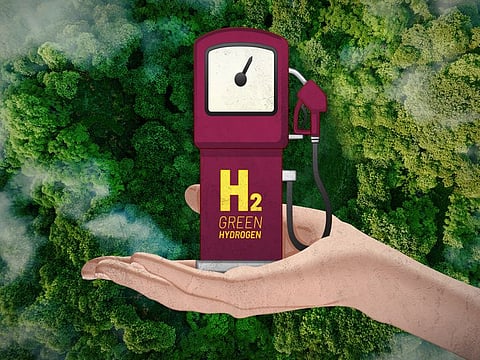Early movers will have clear advantages in Gulf’s green hydrogen push
Gulf states are moving beyond strategy to implementing at scale

Reaching Net Zero global emissions rests on decarbonizing all sectors of our economies, including hard-to-abate ones such as steel, cement, aviation and shipping. And two emerging solutions — low-carbon hydrogen and carbon capture, utilization, and storage (CCUS)—will need to play pivotal roles.
These solutions are costly. The International Energy Agency (IEA) ‘Net Zero Emissions by 2050’ scenario would require up to $13 trillion investments in hydrogen and CCUS from the private sector, of which 15 per cent would be in the Middle East. Commercial banks want to finance hydrogen and CCUS projects to help clients and meet their sustainability goals, but they are wary of the risks.
As 80 per cent of announced low-carbon hydrogen projects worldwide are still in the planning stage, while only around 7 per cent of CCUS projects have reached the FID stage.
Banks expect these projects to meet the same standards and risk as renewable energy projects that are much more mature. Some projects need more time and resources to succeed. Banks rarely offer non-recourse financing.
Thus, borrowers and lenders must understand these projects’ unique characteristics and adjust their expectations accordingly.
Hydrogen projects
The GCC has some of the largest and most advanced hydrogen and CCUS projects. These initiatives should help reduce carbon emissions and promote regional economic diversification. Banks expect that the number of commercially attractive projects will increase due to favorable policy trends, customers’ willingness to pay a green premium, and maturing technology.
For instance, the NEOM Green Hydrogen Project (NGHP) in Saudi Arabia will produce 1.2 million t/y of green ammonia for export. Another relevant regional example is Oman’s green hydrogen auction process, which awarded 5 large-scale projects in its first round, totalng $30 Bn investments and 750 ktpa green hydrogen production.
What’s in store?
Early movers must act as ecosystem enablers, build relationships across the value chain, and bring together stakeholders like export credit agencies, development banks, insurers, and developers. Thus, banks that learn from early deals can seize opportunities, manage risk, and price better.
Government-backed guarantees or Purchase Price Agreements (PPA) reduce investor and bank risk. Regional banks that understand the local market, policy environment, and technologies and strengthen relationships with energy sponsors and developers are especially relevant.
Early movers can shape the space together with these other key players. Once an early-mover bank builds partnerships in a specific area, the collaboration opportunities for followers are few. Here are the steps that are key to being a successful early mover in the GCC:
For instance, the NEOM Green Hydrogen Company has signed agreements with local, regional, and international banks where the financing for the world’s largest green hydrogen production facility located in NEOM is structured with significant participation from Saudi Industrial Development Fund (SIDF) and the National Infrastructure Fund (NIF).
Early movers can understand project risks better, enjoy higher returns, capture key relationships across the value chain—and gain share in two important and growing markets. Banks that want to lead in this space cannot wait for the market to come to them with all potential problems solved. They must go to the market—actively helping to create, shape, and win future opportunities.
Sign up for the Daily Briefing
Get the latest news and updates straight to your inbox









